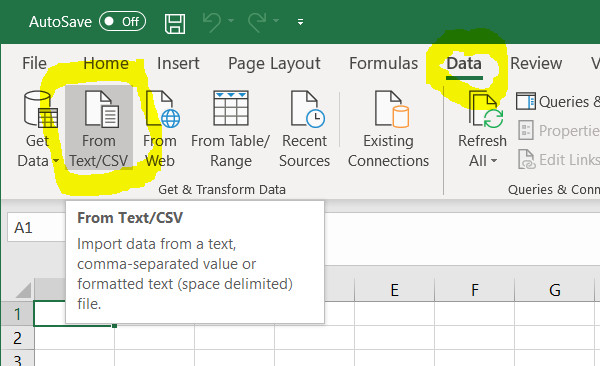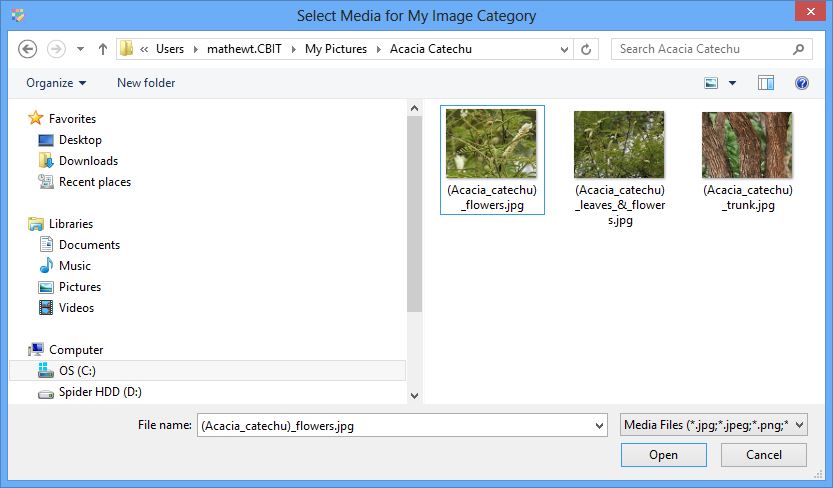Media Manager
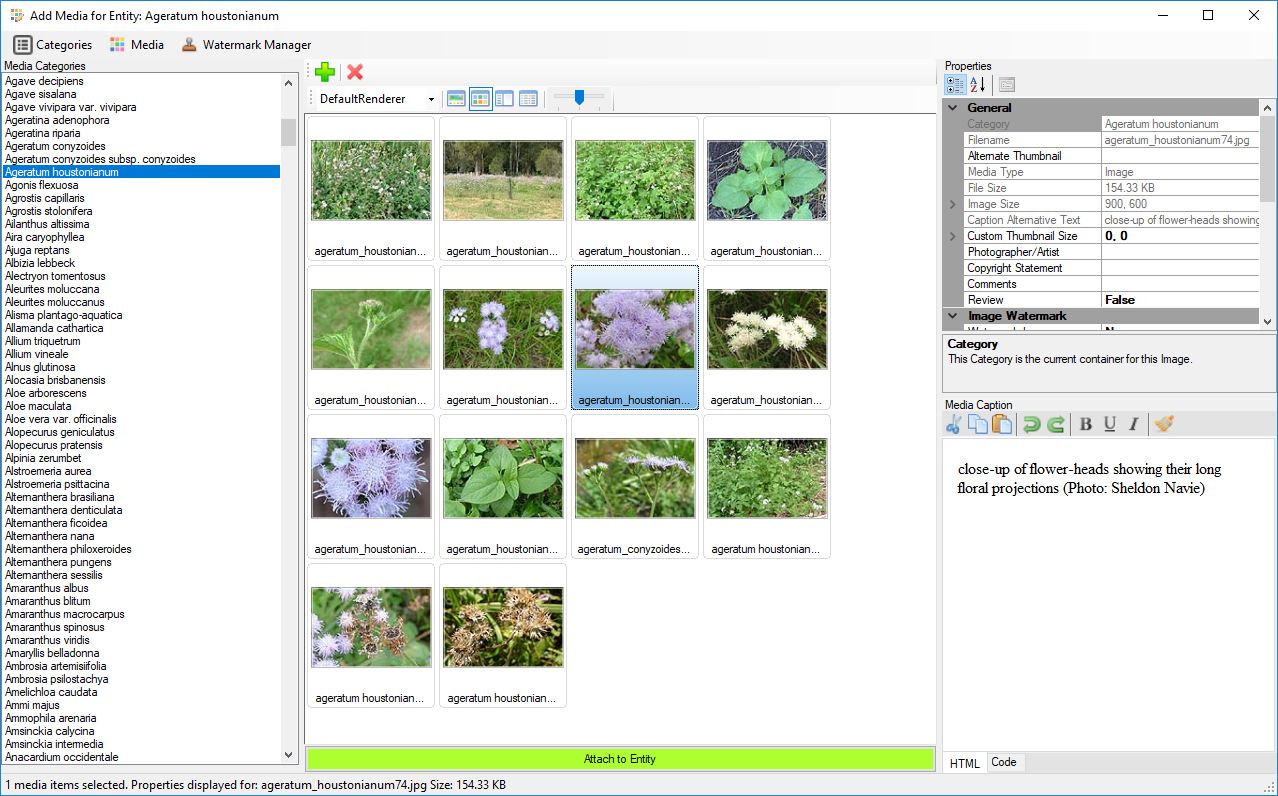
The Fact Sheet Fusion Media Manager is a centralized repository
for media for all projects within the loaded Fusion Database. It
allows images and other media such as Office document, PDFs and
videos to be added. Details such as captions and copyright only
need to be entered once against each media item. When a media item
is then added to a project element (entity, topic, glossary etc)
it automatically inherits the assigned library settings and
values. Of course if you need to customize these settings on an
individual case by case basis, this is possible. To override the
library settings, you just set the media item to be derived. You
may switch between library and derived settings at anytime. More
information on this is outlined below. You can also double click
on any media item to view it. Images have an in-built image viewer that allows you to
preview and adjust image and text watermarks.
You can access the Media Manager via the main interface via the
Edit...Media Manager menu (Ctrl+M), or via its icon (![]() ) on a toolbar
) on a toolbar
Media Categories
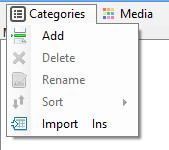
Media Categories are containers (or folders) to help manage a
large number of media. You can define as many Media Categories as
desired. Media categories can hold any supported media types.
Adding a Category

To add a new media category either select the 'Add' option from the Categories menu, or right click in the Media Categories list and select 'Add' from the pop-up context menu. The add category dialog will appear. Enter the category name and click the add button. The new category will be added below the currently selected category.
Removing a Category
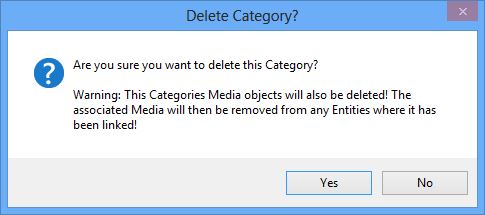
To remove a Category give it focus by selecting it in the Media
Category list. Then either select 'Delete' from the Categories
menu, right click on the selected Category context pop-up menu, or
simply press the delete key. Prior to deletion you will be given a
warning you are about to delete. There is no undo to this
action.
Warning: If you delete a media category containing media
items then all the associated media items will also be deleted. If
these media items are linked to project elements such as entities
or topics the media will automatically be unlinked from them.
Sorting Categories
You can manually sort Media Categories to your preferred order by
drag and drop. Just select the desired category, hold down the
left mouse button and drag the category to the desired position
within the Media Category list, then let go of the left mouse
button. Alternatively you can sort the Media Categories into
ascending or descending order. Either select your preferred sort
option from the Categories menu or by right clicking the Media
Category list and selecting the sort preference from the pop-up
sort menu.
Importing Categories
If you wish to create several Media Categories at once then use
the Import option. This will allow you to paste or type a list of
categories. Each Media Category name should be placed onto a
separate line. Once you have finished entering your Media
Categories click the 'Import' button. The Media Categories will
then be added to the list.
Media List
To the right of the Media Categories list is the media list. Media
items found in the selected category will be listed here. There
are a number of options available to view media.
Media Renderer
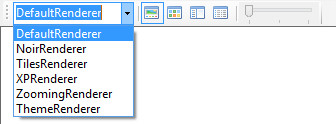
The media renderer offers six different themes to display the
media. The choice of media renderer is completely up to the
individual user. No one theme offers any additional functionality,
it only affects the look of the media list. To change renderer
just select the preferred one from the drop down list. The new
theme will then automatically be applied. Your preferred choice
will automatically be saved once the form is closed.
Media Views
There are several media views that can be applied to the media
list. They are:
Gallery View
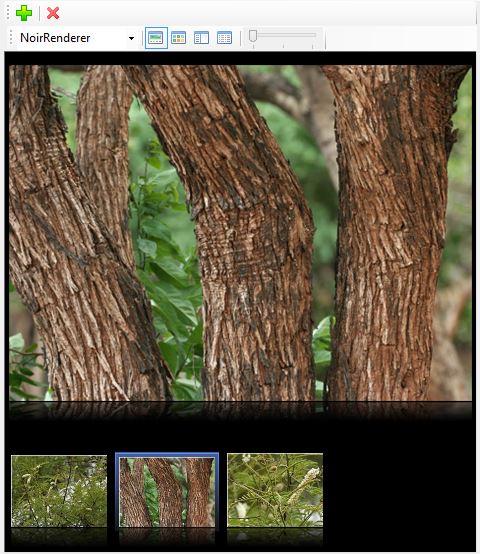 |
| Gallery view using Noir theme |
The gallery view will render the selected image in the middle of
the image list, while the media items are rendered as thumbnails
horizontally below. You can move between the media items by
clicking on the thumbnail image with your mouse or simply using
the left and right arrow keys.
Thumbnail View
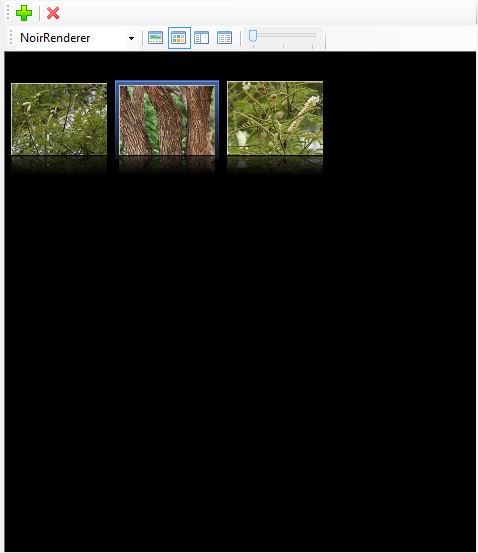 |
| Thumbnail view using Noir theme |
The thumbnail view thumbnails each media item in a grid. Media
items can be selected by the mouse or navigated by using the arrow
keys.
Details Pane
 |
| Details view using Noir theme |
The details pane lists each media item as a file listing, with
detail on the file name, media dimensions and file size.
Thumbnail size
The media thumbnails can be displayed at three different sizes.
Use the thumbnail size slide bar to adjust the thumbnail size.
Your preferred size will be automatically remembered when the form
is next opened.
Adding and removing media
Before media can be added to a project you must first create a
Media Category to hold it. There are several ways in which to add
media to a Category.
1. Select the media category you wish to add media to then select
'Add' from the Media menu (shortcut key combination is
Ctrl+space). Or you can right click in an empty area of the media
panel and select 'Add' from the pop-up context menu, or click the
add media button on the media panel toolbar.
![]()
You will then be presented with a media browser dialog.
When adding media you can select one or multiple items in the
media browser dialog. To select multiple media items you can use
either the Ctrl key or Shift key. The Ctrl key allows the
individual selection of images, while the Shift key allows images
to be selected in blocks.
Once you have selected your preferred media they will then be
copied to your Fusion database media store folder and listed
within the selected Media Category.
2. You can use drag and drop to add media from a Windows
application, such as File Explorer to the selected Categories
media panel. A copy of this media will be automatically copied
across to the fusion database media store and listed in the
selected Media Category.
3. Use copy and paste to add media from internal or external
sources of media to the media panel. You can use the in-built
Windows clipboard for adding media items to a Category. When
copying media from an external source such as Windows File
Explorer use the Copy command (Ctrl+C), then select the desired
category and paste the media to it using the menu, context menu or
keyboard command (Ctrl+V). For moving media internal to the Media
Manager see the Moving Media topic.
For information about attaching media to Topics, Entities and
Glossary Terms please see the Media help
topic.
Supported media
Fact Sheet Fusion supports most media types. Media that is not
considered Internet friendly such as Tiffs, Bitmaps etc will be
automatically converted and optimized when exported.
Supported media include:
Images |
Videos |
Sound |
Office Formats |
Other |
| JPEG | AVI | MP3 | Word |
|
| PNG | MPEG | WAV | Excel |
|
| GIF | MP4 | M4P | PowerPoint |
|
| BITMAP | MP2 | OGG | ||
| TIFF | MPV | OGA | ||
| M2V | FLAC | |||
| M4V | AIFF | |||
| 3PG | 3GP | |||
| WEBM | WMA | |||
| MOV | ||||
| QT |
Moving media
You can move media from one category to another using the move
command (Ctrl+X). To do this, select the desired media items
within a category and then select the move option in the Media
menu or via the context pop-up menu. Browse to the destination
category and use the paste command via the menu, pop-up context
menu or keyboard command (Ctrl+V). Moving media within
Categories will not affect media items that have already been
linked to project elements such as Entities, Topics and Glossary
items.
 Importing Media
Importing Media
Import existing media via a CSV file. The CSV column format is as follows:
[Entity Name], [Media Path], [Caption], [Photographer], [Copyright], [Comments], [Watermark Text], [Watermark Filename], [Review], [Exclude], [Sort Order], [Delete]
For example, the following rows are valid:
Entity one, C:\images\entity_one\ent1.jpg,frontal view,Joe Smith,Copyright 2017,Check this image.,Photo by Joe Smith,,FALSE,FALSE,1,FALSE
"Entity two", C:\images\entity two\entity 2.2.png,Top view,,Copyright 2013,,,TRUE,FALSE,2,FALSE
Entity three, C:\images\ent3\e3_bottom_view.jpg,"Bottom View",,,,Find a replacement image,"[EntityName] - copyright [year].",coyright.png,FALSE,FALSE,3,FALSE
As you can see from the examples, each column must be present, even if empty. The columns must be separated via a comma. The columns can optionally be wrapped in double quotes to avoid escaping commas contained in field. The [Media Path] field must be the absolute path to the media item. The content fields can contain HTML tags. Any tags will be automatically cleaned; any tags outside of the body tags will be removed.
The Delete field, if set to 'TRUE', will delete the image within the entity category, if found. If creating a CSV for the purpose of removing media then only the Entity Name, Media Path and Delete fields need hold values. The Media Path value can contain only the media item's filename.
For example:
Entity name example, entity_one_20191.jpg,,,,,,,,,,TRUE
Any errors occurring during the import process will be logged to the default FSF log file. Tip. You can quickly access the log file via the Help…About menu.
Media Properties
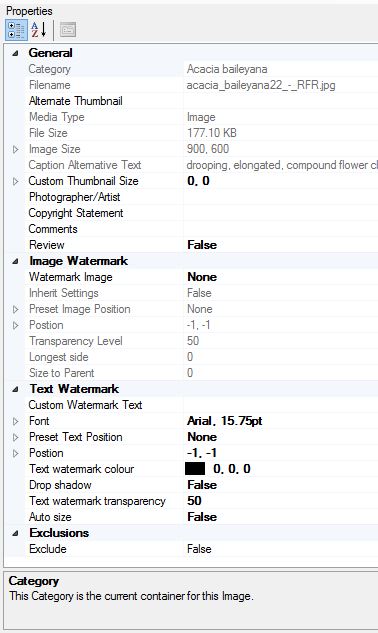 The Media Properties panel is located to the top
right of the media list panel. It displays all of the properties
that are associated with the currently selected media item.
Different properties may be available depending on the media
type. For example only images have watermarking properties
available. Some media properties are informative (read) only,
that is they can't be modified. For example the media file size
is informative only. Informative or read-only properties are
identified by ghosted (light grey) labels, while editable
properties are shown with regular text labels.
The Media Properties panel is located to the top
right of the media list panel. It displays all of the properties
that are associated with the currently selected media item.
Different properties may be available depending on the media
type. For example only images have watermarking properties
available. Some media properties are informative (read) only,
that is they can't be modified. For example the media file size
is informative only. Informative or read-only properties are
identified by ghosted (light grey) labels, while editable
properties are shown with regular text labels.
Properties are grouped within related categories. Each property
group has a Group name (bold) which can be expanded and
collapsed.
Editing a property depends on the property type. Some
properties such as Custom Thumbnail size require two values to
be entered for width and height, while others may be free form
text. Each property has explanatory text associated with it that
is displayed at the bottom of the property panel. This
explanatory text is displayed when the property is selected.
Properties
General (Section)
Category - Shows the name of the Category the selected media is located in.
Filename - Shows the filename associated with the media item. You can, if needed, change the file associated with the media item by clicking on the file browse option on the right ([...]). This will replace the media file with the selected file while maintaining the media properties such as caption and copyright etc. This is useful ,for example, where your filename is extremely long and causes a problem when the exported path exceeds the maximum length. Or if you've modified the media store filename outside the scope of Fact Sheet Fusion, an action which is not recommended unless you are an advanced user.
Alternate Thumbnail - Allows you to select an image to
represent the media item. Media types that don't have a natural
image association such sound files will automatically be
assigned a default alternative thumbnail for that media group.
These default thumbnails are located in the 'Icon' folder of the
Fusion Database media store folder. Selecting this property will
show a browse option that will let you select a custom thumbnail
image file anywhere on your file system. The selected
alternative image will automatically be copied across to your
Fusion media store. Video media items will automatically have a
frame captured and associated as the Alternate Thumbnail. These
defaults can be changed by selecting a different image as
describe above.
Note: You must have installed FFMPEG utility to enable
video frame capture. You link the FFMPEG utility location to
Fact Sheet Fusion via the Preferences dialog.
Media Type - Displays file type of the media item. E.g. Image, Video, PDF etc.
Caption Alternative Text - This text is automatically captured from the HTML Media caption associated with the media. It is a plain text version of this caption. This alternative text, without HTML formatting, can be useful when used in export templates that use JavaScript or require no HTML tags.
Custom Thumbnail Size - You can set a preferred thumbnail size for an individual media item. This can be used rather than the default export thumbnail size. The export dialog will allow you to override the Custom Thumbnail size. Normally consistent thumbnail sizes within fact sheets are desired, but this option allows you to fully customize each thumbnail, if needed.
Photographer - When selected this property will display a small text box to enter the media photographer's details.
Copyright Statement - Similar to the Photographer
property a small text box will be displayed allowing you to
enter a copyright statement for the media item.
Comments - Author comments regarding the media item.
These comments are private and not exported with the fact sheet.
However, they are included as a part of the Media
List file, if exported.
Review - You may mark a media item for review. By doing
so, you can control via the export option whether this media is
included in the fact sheet.
Image Watermark (Section)
Watermark Image - A drop down list of all watermark images that have been added to the project via the Watermark Image Manager. See the Watermark Image Manager for more information on this topic.
Inherit Settings - The Watermark Image Manager can set global default settings for an individual watermark image. This can save applying the same watermark settings to every image the watermark is associated with. If you wish to override the global watermark settings for any selected watermark image then change the Inherit Settings to false. You can change back to the global settings for the selected watermark image anytime. Any custom watermark settings will be saved in case you wish to revert back to the individual custom settings.
Present Image Position - This setting is only available
if a Watermark image has been selected and the Watermark Image
Inherit settings are set to False.
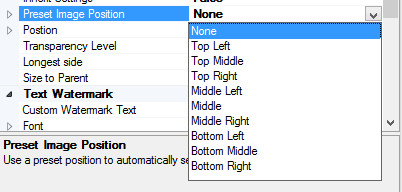
There are nine preset positions where the image watermark can be
placed on the image as shown in the screen capture above. If a
present position is selected this will take precedence over a
manually set position (see Position
Property below).
Position - The position property allows you to set an X
& Y pixel coordinate in relation to the watermark
image and the main image. The image watermark image will be
positioned from its top left at the defined XY coordinates of
the main image. Setting this property is often easier via the
Image viewer as it will dynamically preview the watermark as the
properties are changed. See the Image Viewer help topic for more information on this. The
Position value will be overridden by the Preset Image Position,
if selected.
Transparency Level - The transparency level of the watermark image determines how much of the underlying image shows through the watermark. The transparency level can be between 1 and 100. The lower the value the more transparent the watermark image will be. If the value is set too low the watermark image may be very difficult to see in the main image. Setting a value of 100 means no transparency will be added to the watermark image.
Longest side - You can set the size of the watermark based on the longest side in pixels. This effectively is like defining the size of a square box that the watermark image must fit within while maintaining its aspect ratio. A watermark image will not be resized beyond its actual size if the longest size exceeds the watermark dimensions. Also if the longest side value exceeds the exported image size the watermark will be resized to fit within the image boundary.
Size to parent - You can define a percentage value for
the watermark to the parent image. The Size to parent value must
be between 1 and 100.
Text Watermark
Custom Watermark Text - Enter the text you wish to use as the watermark.
Font - Define the font type and size you prefer for the
text watermark.
Preset Text Position - There are nine preset positions
where the text watermark can be placed on the image. If a
present position is selected this will take precedence over a
manually set position (see Position
Property below).
Position - The position property
allows you to set an X & Y pixel coordinate in relation to
the watermark text and the image. The text watermark will be
positioned from its top left at the defined XY coordinates of
the main image. Setting this property is often easier via the
Image viewer as it will dynamically preview the watermark as the
properties are changed. See the Image Viewer help topic for more information on this. The
Position value will be overridden by the Preset Text Position if
selected.
Text Watermark Color - Define the color of the text
watermark.
Drop Shadow - Applies a drop shadow to the text watermark.
The drop shadow can add more definition to the text making it
clearer on the image it's applied to.
Text watermark Transparency - The transparency level of
the text watermark determines how much of the underlying image
shows through the text watermark. The transparency level can be
between 1 and 100. The lower the value the more transparent the
text will be. If the value is set too low the text may be very
difficult to see in the main image. Setting a value of 100 means
no transparency will be added to the text watermark.
Auto Size - The auto size option automatically sizes the
font based on the size of the image it's being applied to and
the position that has been selected.
Media Caption
Add text associated with the image. The caption text is HTML
based and has the mini HTML editor
associated with it.
Global Caption Clean
Media Usage Reports
The media usage report shows all usage of selected media throughout all projects. This is particular useful if you want to permanently delete a media item. Or to check associated derived captions.
To generate a report select one or more media items in the
media manager. Then right click to view the media pop-up context
menu or press Ctrl+R. A report will then be generated on the
selected media and displayed in the Usage Report dialog.
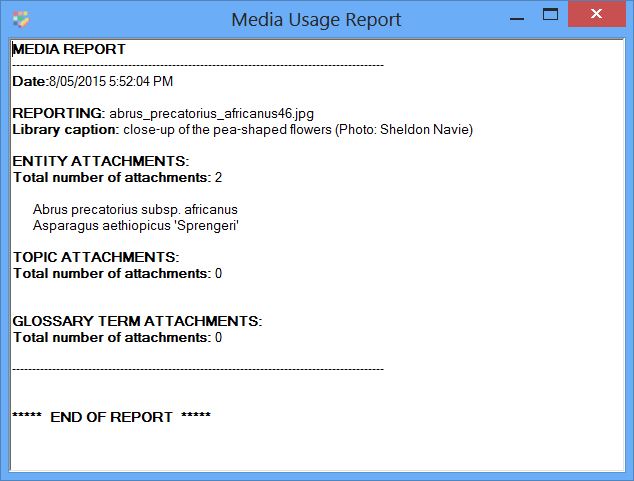
Media Usage Report example.
Advanced Options

Fact Sheet Fusion has several options for advanced users when dealing with media. Please read the help on any of these options prior to using as in most instances there is no undo action available.
Auto match and attach category media option
This option will automatically attach any media found in the media manager entity categories to the corresponding project entities. This is useful for example after performing a large media import and saves having to attach each entities media items 'by hand'.
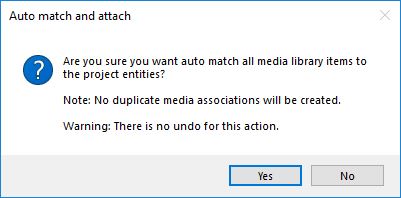
Auto match and attach from media store to media manager
This option will search the currently opened Fusion database category sub folders found in the 'Media' folder location for any media files that have not yet been attached. Any unattached media found is then automatically added to the media manager under the corresponding category. No duplicate attachments will occur. This option does not attach the found images to the project entities. For this option use the 'Auto match and attach category media' option as described above.
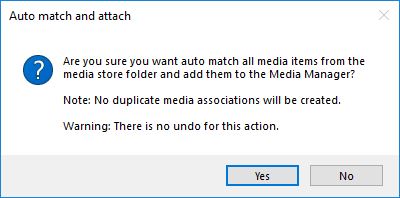
Remove attached media, excluding derived, from the project
This option removes the entity media attachments for the project, excluding derived media attachments. This doesn't delete media. It only removes the image links that have been associated with an entity in the current project. Derived images aren't removed as this custom information associated with the image would be lost since it is stored on the basis of the link between the entity and the media item.
Remove attached media, including derived, from the project
This option removes the entity media attachments for the project, including derived media attachments. This doesn't delete media. It only removes the image links that have been associated with an entity in the current project. Derived images are also removed. This will result in the loss of any custom associated information or setting options for that entity image.
Report Missing Media from Store
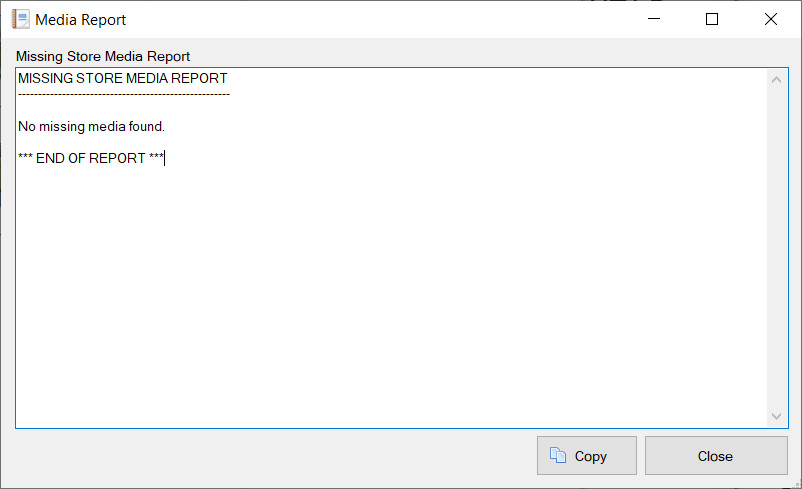
All media stored within the media manager will be checked for missing files where moving, renaming or deleting may have taken place outside the scope of Fact Sheet Fusion, breaking the link between the Fact Sheet Fusion database and the file system. E.g. Via the operating system file manager.
Broken media within the Media Manager will not show a thumbnail, but rather a small media icon.
Note: It is highly recommended that you do not move, edit or delete media files found in the FSF database Media folder using the Windows file manager.
Delete Missing Media from Store
Manual changes to the Fusion databases Media folder content is strongly discouraged, however some advanced users like to manually delete unwanted media from the media store. When this happens it does so outside the scope of Fact Sheet Fusion. When the media manager is loaded these deleted files will be shown as broken media. This option can be used to clean out these now defunct records from the media manager.
Export Media CSV
References to all media items will be exported to a CSV file. The format (columns of data) mirror that of the CSV media import file format.
After selecting to export a file browser dialog will allow you to choose a folder and filename in which to save the CSV. Once completed you will see a completion dialog.
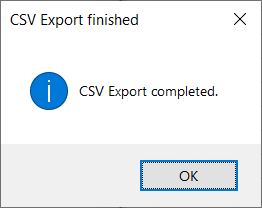
Opening the CSV in Excel
If you wish to open the CSV file in Excel, use the Data menu 'From Text/CSV' option, rather than trying to open it via the File...Open menu. As shown in the screen shot below.
